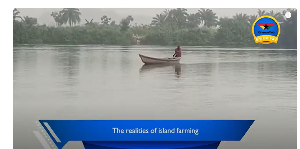Correspondence from Eastern Region
For many, living on an island may not seem like a big deal, especially for those who grew up with it. Island life becomes just a way of living. You don’t consider it more challenging — at least not until you venture into farming and begin organizing inputs and managing logistics.
In the Asuogyaman District of the Eastern Region, many farmers find themselves cultivating crops on some of the 60 islands within its jurisdiction.
One of the greatest limitations to island food production is the simple lack of space for large-scale farming. Many of these islands are small, with insufficient land available for expansive production.
Despite these challenges, Justice Appiah, a farmer who has cultivated crops on an island near Atimpoku for over ten years, describes island farming as a good business. He crosses the water daily to reach his 35-acre farm, which is surrounded by a mass of water. Although he owns a boat, he was forced to use a canoe today because his boat had broken down.
Undoubtedly, farming on an island presents unique challenges not faced by mainland farmers. According to the farmers, the biggest challenge is that everything must be ferried to and from the island — fuel, feed, fertilizer, parts, small machinery, products, and produce — literally everything.
When asked about the dangers they face while crossing the river to reach their farms, Justice mentioned that rain poses a significant threat. Heavy rainfall hinders smooth crossings, and farmers must often wait until the weather improves to safely ferry across the lake.
During the harvest season, boats and canoes are used to transport food to the mainland for further transportation to market centers and clients, particularly bulk buyers who are Justice’s major customers.
On his 35-acre island farm, Justice cultivates cassava, maize, mangoes, and plantains. As a farmer who also owns land on the mainland, he notes that his island farm yields more bountiful harvests than his mainland farm, which is located on a mountain.
Like their mainland counterparts, island farmers rely on irrigation to water their crops. Mr. Antwi Tenadu, another island farmer, explains that irrigation is particularly crucial for growing vegetables like cucumber, squash, and yellow melon, especially during the dry season.
However, the high cost of irrigation is a significant challenge. According to Mr. Tenadu, it costs thousands of cedis per season to pump water to the farms and prevent the crops from dying. “Irrigating a one-acre farm will cost you not less than GH₵5,000 during the dry season, especially when the harmattan sets in,” he revealed. Unfortunately, a pump at the riverbank to power the irrigation system has broken down.
Another issue island farmers face is their inability to use large farm machinery. Due to logistical challenges, they cannot transport heavy equipment to the islands. As a result, farmers rely on smaller, portable equipment like handheld mowers to carry out their farming activities.
“It’s a problem that farm machinery can’t come here. If we could get a hand mower, it would help us plough the land,” lamented Mr. Tenadu.
Additionally, the farmers sometimes encounter storms while crossing the river. The smaller canoes used by farmers are at risk of being hit by waves created by larger vessels speeding across the water, which could potentially capsize their boats.
Mr. Tenadu expressed concern about the high cost of farming inputs and appealed to the government to intervene and provide support to keep island farmers in business.
Watch the video below:
This story was originally published in 2023 and has been republished for educational purposes.
Regional News of Saturday, 21 September 2024
Source: www.ghanaweb.com

















